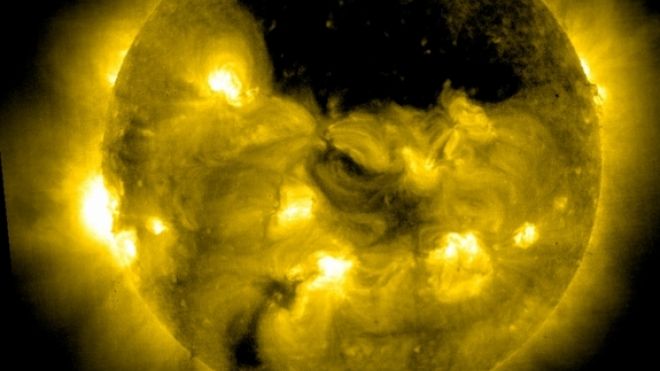It looks like you're using an Ad Blocker.
Please white-list or disable AboveTopSecret.com in your ad-blocking tool.
Thank you.
Some features of ATS will be disabled while you continue to use an ad-blocker.
0
share:
Spacecraft sees giant 'hole' in sun
www.foxnews.com...
A space telescope aimed at the sun has spotted a gigantic hole in the solar atmosphere — a dark spot that covers nearly a quarter of our closest star, spewing solar material and gas into space.
The so-called coronal hole over the sun's north pole came into view between July 13 and 18 and was observed by the Solar and Heliospheric Observatory, or SOHO. NASA released a video of the sun hole as seen by the SOHO spacecraft, showing the region as a vast dark spot surrounded by solar activity.
Coronal holes are darker, cooler regions of the sun's atmosphere, or corona, containing little solar material. In these gaps, magnetic field lines whip out into the solar wind rather than looping back to the sun's surface. Coronal holes can affect space weather, as they send solar particles streaming off the sun about three times faster than the slower wind unleashed elsewhere from the sun's atmosphere, according to a description from NASA.
"While it’s unclear what causes coronal holes, they correlate to areas on the sun where magnetic fields soar up and away, failing to loop back down to the surface, as they do elsewhere," NASA's Karen Fox at the agency's Goddard Space Flight Center in Greenbelt, Md., explained in an image description.
These holes are not uncommon, but their frequency changes with the solar activity cycle. The sun is currently reaching its 11-year peak in activity, known as the solar maximum. Around the time of this peak, the sun's poles switch their magnetism. The number of coronal holes typically decreases leading up to the switch.
After the reversal, new coronal holes appear near the poles. Then as the sun approaches the solar minimum again, the holes creep closer to the equator, growing in both size and number, according to NASA.

edit on 30-7-2013 by Skywatcher2011 because: added .gif image as
link
reply to post by Skywatcher2011
Yes. It's been posted several times now.
The large coronal hole is now gone.
sdo.gsfc.nasa.gov...
Yes. It's been posted several times now.
The large coronal hole is now gone.
sdo.gsfc.nasa.gov...
Originally posted by Phage
reply to post by Skywatcher2011
Yes. It's been posted several times now.
The large coronal hole is now gone.
sdo.gsfc.nasa.gov...
It doesn't do anything besides be a big black hole?
reply to post by yourmaker
or bring too rememberance,, "black as sack cloth",,,,which in and off itself a remarkable weave ,,too say say the least,,
ohh hi Page,,
or bring too rememberance,, "black as sack cloth",,,,which in and off itself a remarkable weave ,,too say say the least,,
ohh hi Page,,
Hey phage, would that kind of hole be dangerous if earth facing?
Posted elsewhere...and as noted above, the hole is now gone......and this thread is now closed
edit on Tue Jul 30 2013 by DontTreadOnMe
because: (no reason given)
new topics
-
Gaetz withdraws from attorney general consideration
US Political Madness: 36 minutes ago -
Bridgewater Triangle
General Chit Chat: 38 minutes ago -
Is Russia Using a New Type of Beam Weapon Against Ukraine?
Weaponry: 2 hours ago -
Here is why Western leaders in NATO have zero fear of nuclear warfare. At all. Zero.
World War Three: 3 hours ago -
International Criminal Court Issues Arrest Warrant For Netanyahu
Breaking Alternative News: 4 hours ago -
racist rant, but she made the arguement to get rid of DEI
US Political Madness: 5 hours ago -
Well we know Putins ICBMs won't fail in their silos
World War Three: 5 hours ago
top topics
-
FEMA Head Admits Agency Skipped 20 Homes with Trump Signs
Mainstream News: 16 hours ago, 19 flags -
Yet another Hack...
Rant: 17 hours ago, 14 flags -
Well we know Putins ICBMs won't fail in their silos
World War Three: 5 hours ago, 12 flags -
racist rant, but she made the arguement to get rid of DEI
US Political Madness: 5 hours ago, 9 flags -
International Criminal Court Issues Arrest Warrant For Netanyahu
Breaking Alternative News: 4 hours ago, 8 flags -
Is Russia Using a New Type of Beam Weapon Against Ukraine?
Weaponry: 2 hours ago, 6 flags -
Why isn't Psychiatry involved?
Social Issues and Civil Unrest: 12 hours ago, 4 flags -
Here is why Western leaders in NATO have zero fear of nuclear warfare. At all. Zero.
World War Three: 3 hours ago, 4 flags -
Help in song interpretation
Music: 13 hours ago, 3 flags -
Bridgewater Triangle
General Chit Chat: 38 minutes ago, 1 flags
active topics
-
International Criminal Court Issues Arrest Warrant For Netanyahu
Breaking Alternative News • 27 • : Dalamax -
-@TH3WH17ERABB17- -Q- ---TIME TO SHOW THE WORLD--- -Part- --44--
Dissecting Disinformation • 3335 • : Thoughtful3 -
Well we know Putins ICBMs won't fail in their silos
World War Three • 78 • : andy06shake -
Gaetz withdraws from attorney general consideration
US Political Madness • 1 • : Kaiju666 -
Is Russia Using a New Type of Beam Weapon Against Ukraine?
Weaponry • 5 • : andy06shake -
Help in song interpretation
Music • 9 • : FullHeathen -
President-elect TRUMP Picks MATT GAETZ for his ATTORNEY GENERAL - High Level PANIC Ensues.
2024 Elections • 117 • : network dude -
racist rant, but she made the arguement to get rid of DEI
US Political Madness • 7 • : KnowItAllKnowNothin -
Bridgewater Triangle
General Chit Chat • 0 • : Shoshanna -
Why isn't Psychiatry involved?
Social Issues and Civil Unrest • 11 • : lilzazz
0
